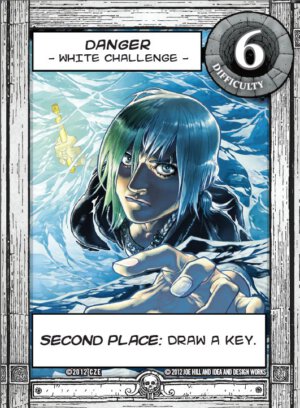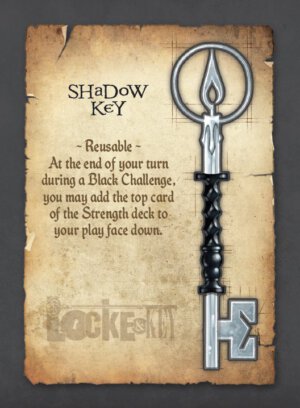
Publisher: Cryptozoic Entertainment
Designer: Matt Hyra
Year: 2012
Players: 3 – 6
Ages: 15+
Playing Time: 30 Minutes
Retail Price: $30.00
Category: Card Game
Components:
- 150 Strength cards
- 19 Challenge cards
- 15 Key cards
- 1 Rulebook
- 1 Omega Lock initiative marker
From Cryptozoic Entertainment:
Come meet the Locke family and take a tour of the mysterious Keyhouse…
Locke & Key tells the story of the Locke family and Keyhouse, an unlikely New England mansion that is home to fantastic keys that transform all who dare to use them . . .and a hate-filled creature that will not rest until it forces open the most terrible door of them all.
Competition and cooperation meet in this card game that dares you to overcome the supernatural challenges of Keyhouse. You and your fellow players will face these horrors together, but who will be by your side when the dust settles? On this journey, you’ll make decisions on when and where to help your fellow players, but your resources are not endless. Through careful management of your cards, you can help the family overcome challenges, and you’ll be rewarded for the assistance . . . sometimes.
Locke & Key started as a graphic novel. Well actually there are three but I have only read the first one. It’s the story of the Keyhouse, a mysterious New England mansion where some of the doors lead to transformations to the characters that go through them. It’s of the horror genre, so I was drawn to it.
This is a card game, and the cards look great as all of the artwork was done by Gabriel Rodriguez, the artist from the 
The object of the game is to score the most points by the time the Game Over challenge card is revealed.
There are three types of cards and they come in three different colors (suits) of Black which represents the shadow army, White which represents personal and psychological problems, or Blue which represents otherworldly encounters.
The challenge cards are the main cards that determine the points you score and the end of the game. At the start of the game you shuffle the Game Over card into the bottom six cards of the challenge deck, so that you are never quite sure when the game will end. Each challenge is of one of the three colors and has a numeric value on it. This number is the total the players must meet or beat with the Strength cards to win the challenge. Once a challenge is defeated, the player who played the most points in strength cards wins the challenge card and places it into their score pile. The Challenge cards also have a second place reward listed on them for the player who played the next highest point total. The winner also receives the lock token which enables them to play their cards first on the next challenge.

The Key cards are special cards that are either one time use or reusable, depending on the key you draw. Each one does some special action like changing the color of a card you played, or drawing an extra card, etc.
You pick a starting player randomly, and they are given the lock token. The top challenge card is flipped over, and each player has a choice of three actions. You can either play up to three strength cards face down to try and defeat the challenge, or pass and draw a new strength card, or pass and draw a key card from the key deck. The lock player goes first and then play proceeds clockwise from there.
Once everyone has played their cards or passed the played cards are flipped over. Before the challenge is resolved all players have a chance to play a key card if they wish. Then all points of the cards matching the color of the challenge are added up. If they are equal or higher than the challenge card, then the challenge is won. The player who played the most points in strength cards gets the challenge card and scores the points on it. The second highest points played gets the reward listed on the challenge card. If players tie, the player turn order determines who wins and who gets second place. The winner of the challenge gets the lock token and will play first next round. If the challenge isn’t defeated the card goes to the bottom of the challenge deck and no one scores any points.
This is repeated until the Game Over card is flipped up. The players add up all of their points in their score pile, and the highest total wins.

One of the interesting mechanics that add some strategy to the game is the fact that you can play cards of any color when facing a challenge. So you can fool the other players into thinking you are going all out, either forcing them to drop out of a challenge because they think they can’t win, or making them go all out to win. You see the strength cards are a valuable resource as the main way to get new ones is to pass on your turn. When you run out you have no choice but to pass, and you can’t pass too often because there really aren’t that many rounds. Hand management plays as big of a role as the luck of the draw does.
This is a pretty fun game. The games are short and it makes a good filler or a game to play as a gateway game. The kids liked it a lot and although it seems like it is too simple to be fun, that isn’t the case. It’s actually pretty addictive. The art gets a PG-13 rating from me so I’d advise against playing it with the young ones. I liked it and think it is a good time.
- A Dungeon Delve for Kids?: A Review of Dungeon! - Oct 24, 2022
- Better, Stronger, Faster | Descent: Journeys in the Dark Second Edition Reviewed - Oct 23, 2022
- Your Planet is Doomed!: Invasion from Outer Space Reviewed - Oct 22, 2022











